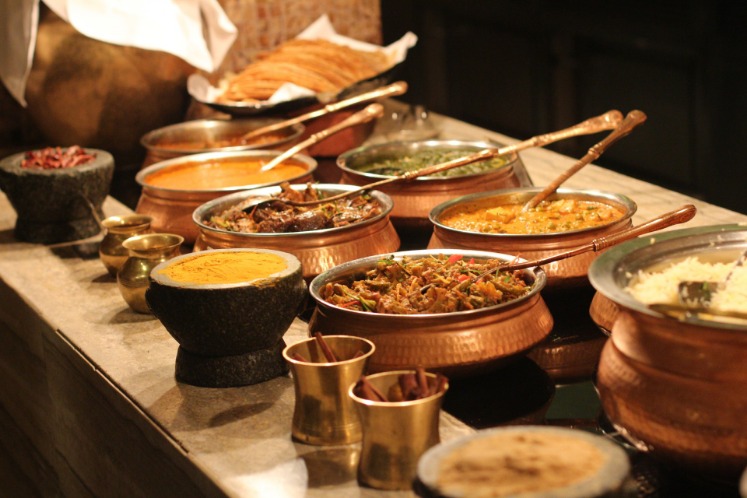Traditional Ethiopian Dishes
Traditional Ethiopian dishes offer a rich and unique culinary experience that reflects the country’s diverse culture and history. Known for their bold flavors and communal serving style, these dishes often feature injera, a sourdough flatbread, paired with a variety of flavorful stews and vegetables. Exploring Ethiopian cuisine provides a delicious insight into the country’s vibrant traditions and hospitality.
Injera
Traditional Ethiopian dishes are renowned for their rich flavors and cultural significance, with Injera being a central element of the Ethiopian culinary experience. Injera is a sourdough flatbread made from teff flour, known for its spongy texture and slightly tangy taste. It serves as both a plate and utensil, used to scoop up various flavorful stews and dishes such as Doro Wat, Kik Alicha, and Atakilt Wat. The unique preparation process and the communal manner in which Injera and other traditional foods are enjoyed reflect the warmth and hospitality of Ethiopian culture. As one of the best foods in Ethiopia, Injera embodies the country’s culinary identity and offers a delicious glimpse into its ancient culinary traditions.
Berbere Spiced Dishes
Traditional Ethiopian dishes are renowned for their rich flavors and cultural significance, offering a unique culinary experience. One of the most iconic elements of Ethiopian cuisine is the use of Berbere spice, a vibrant blend of chili peppers, garlic, ginger, and other spices that add robust flavor and heat to many dishes. Berbere spiced dishes often include hearty stews like Doro Wat, a spicy chicken stew, and Siga Wat, a flavorful beef stew, both served with injera, a sourdough flatbread that is a staple in Ethiopian meals. These dishes highlight Ethiopia’s diverse use of spices and ingredients, creating a delicious and memorable dining experience. Whether enjoyed at traditional gatherings or in modern restaurants, Berbere-spiced dishes are considered some of the best food in Ethiopia, showcasing the country’s rich culinary heritage.
Shiro Wat
Shiro Wat is one of the most beloved traditional dishes in Ethiopia, renowned for its rich flavor and comforting warmth. This hearty stew is made from ground chickpeas or broad beans combined with spices such as garlic, ginger, and chili, creating a thick, savory sauce. Typically served with injera, a spongy flatbread, Shiro Wat is a staple during communal meals and special occasions. Its simplicity and deep flavors make it a favorite among locals and visitors alike, exemplifying the vibrant culinary heritage of Ethiopia.
Doro Wat
One of the most celebrated traditional Ethiopian dishes is Doro Wat, a spicy chicken stew that exemplifies the rich flavors of Ethiopian cuisine. Made with tender chicken pieces simmered in a thick, flavorful sauce infused with berbere spice mix and niter kibbeh, Doro Wat is often served with injera, a sourdough flatbread that acts as both a plate and utensil. This dish is typically accompanied by boiled eggs, adding to its hearty and satisfying nature. Doro Wat holds cultural significance and is a staple in Ethiopian celebrations and holidays, representing the vibrant culinary heritage of Ethiopia. Its unique combination of spices and ingredients makes it one of the best foods to experience in Ethiopia, offering a taste that is both bold and authentic.
Popular Ethiopian Snacks and Side Dishes
Ethiopian cuisine is renowned for its rich flavors and diverse array of snacks and side dishes that complement the main meals. These popular treats offer a taste of Ethiopia’s culinary heritage, showcasing unique ingredients and traditional preparation methods. From savory bites to flavorful accompaniments, Ethiopian snacks and side dishes are an essential part of the country’s vibrant food culture.
Kitfo
Kitfo is one of the most popular and beloved Ethiopian snacks and side dishes, known for its rich flavors and cultural significance. This traditional dish consists of finely minced raw beef, seasoned with spices such as mitmita and niter kibbeh, and often served with injera, a type of sourdough flatbread. Kitfo can be prepared in various ways, including cooked or rare, depending on personal preference. It is commonly accompanied by mild cheese called ayib and a garden salad, making it a hearty and flavorful addition to any Ethiopian meal. As a staple in Ethiopian cuisine, Kitfo exemplifies the country’s culinary heritage and is enjoyed by locals and visitors alike, showcasing Ethiopia’s love for bold spices and communal eating traditions.
Gored Gored
Gored Gored is a beloved Ethiopian snack known for its rich flavors and traditional preparation. It is made from raw or lightly cured beef, typically sliced into small pieces and seasoned with spices, clarified butter, and sometimes chili. This dish is often enjoyed as a quick appetizer or side dish, showcasing Ethiopia’s love for flavorful, spicy, and fresh ingredients.
- Injera – A sourdough flatbread that serves as the base for many Ethiopian dishes, often used to scoop up Gored Gored.
- Kitfo – Minced raw beef seasoned with spices, similar to Gored Gored, but usually minced and served with variations of clarified butter and spices.
- Shiro – A delicious savory stew made from ground chickpeas or broad beans, often served alongside Gored Gored as part of a traditional meal.
- Timtimo – Spicy lentil salad that complements the flavors of Gored Gored and other Ethiopian dishes.
- Ayib – Ethiopian homemade cottage cheese that pairs well with spicy dishes like Gored Gored, balancing the flavors.
These dishes highlight the rich culinary tradition of Ethiopia, emphasizing bold flavors, aromatic spices, and communal dining experiences, making Gored Gored a must-try food in Ethiopia’s diverse cuisine.
Tiwi
Tiwi is one of the most popular Ethiopian snacks and side dishes that exemplifies the rich culinary traditions of Ethiopia. It is a traditional dish made from fermented barley or wheat, often mixed with spices and served with sugar, honey, or clarified butter for added flavor. Tiwi is valued for its unique taste and nutritional benefits, making it a favorite among locals and visitors alike. Besides Tiwi, Ethiopia offers a variety of other beloved snacks and side dishes such as injera with various wats, split peas stew, and kocho, which together showcase the diverse and flavorful food heritage of the country. These dishes are often enjoyed during communal meals and special occasions, reflecting Ethiopia’s vibrant food culture.
Ayib and Atay
Popular Ethiopian snacks and side dishes are an essential part of the country’s rich culinary tradition. Among these, Ayib is a beloved Ethiopian cheese made from homemade fresh cheese mixed with spicy butter and sometimes heated to enhance its flavor. It is often served as a side dish or accompaniment to various traditional meals, adding a creamy and tangy taste that complements spicy dishes perfectly.
Atay, also known as Ethiopian tea, is a traditional hot beverage enjoyed throughout Ethiopia. It is typically brewed strong and often flavored with a variety of spices or herbs, making it a comforting and aromatic drink. Atay is commonly served during social gatherings or as a refreshing accompaniment to meals, highlighting the Ethiopian love for flavorful teas.
Both Ayib and Atay exemplify the delightful diversity of Ethiopian cuisine, showcasing the country’s unique approach to combining flavors and textures in everyday eating. These dishes and beverages are integral to experiencing the best food in Ethiopia.
Vegetarian and Vegan Options

When exploring the best food in Ethiopia, it’s important to highlight the diverse vegetarian and vegan options available. Traditional Ethiopian cuisine offers a variety of flavorful dishes that cater to plant-based diets, making it a delicious and satisfying choice for vegetarians and vegans alike. From hearty stews to fresh salads, Ethiopia’s culinary heritage provides a rich array of meat-free alternatives to enjoy.
Misir Wat (Spicy Lentils)
In Ethiopia, one of the standout vegetarian and vegan options is Misir Wat, a flavorful and spicy lentil stew that is a staple in Ethiopian cuisine. Made with red lentils simmered in a rich blend of berbere spices, garlic, onions, and sometimes flavored with ginger or other herbs, Misir Wat offers a hearty and satisfying meal for those avoiding meat. It is commonly served with injera, the traditional Ethiopian flatbread, which complements the dish perfectly and makes for a complete, protein-rich meal. This dish exemplifies Ethiopia’s diverse and vibrant culinary tradition, showcasing how plant-based ingredients are celebrated in the country’s best foods.
Selata (Ethiopian Salad)
Vegetarian and vegan options are abundant and flavorful in Ethiopian cuisine, making it a popular choice for health-conscious and ethical diners. Ethiopian dishes often feature an array of vegetables, legumes, and spicy stews that cater to plant-based diets. One of the most renowned vegan-friendly dishes is the selection of vegetable stews served on injera, a traditional sourdough flatbread. These include dishes like misir wat (spicy lentil stew), kik alicha (mild split pea stew), and gomen (sautéed collard greens).
Selata, the Ethiopian salad, is a refreshing and healthy option that typically includes fresh, diced vegetables like tomatoes, onions, peppers, and cucumbers, seasoned with lemon juice and spices. It’s a perfect accompaniment to the rich, flavorful stews and offers a cool, crisp contrast. Ethiopian salads and vegetable dishes are known for their vibrant flavors and emphasis on natural ingredients, making them some of the best vegetarian and vegan options available in Ethiopia’s diverse culinary landscape.
Kik Alicha (Yellow Split Peas)
One of the best vegetarian options in Ethiopia is Kik Alicha, a delicious and hearty dish made with yellow split peas. It is popular among those seeking plant-based meals and showcases the rich flavors of Ethiopian cuisine.
- Kik Alicha is naturally vegan and free from animal products, making it suitable for vegans.
- The dish is seasoned with turmeric, which gives it a vibrant yellow color and a warm, aromatic flavor.
- It is typically served with injera, the traditional Ethiopian flatbread, creating a wholesome and satisfying meal.
Traditional Ethiopian Beverages
Traditional Ethiopian beverages hold a special place in the rich cultural heritage of Ethiopia. These drinks are deeply rooted in the country’s history and social customs, often served during celebrations and communal gatherings. From the iconic fermented honey wine known as Tej to the invigorating coffee that originates from Ethiopia’s legendary coffee ceremonies, these beverages offer a unique taste of Ethiopian tradition and hospitality.
T’ej (Honey Wine)
One of the most cherished traditional beverages in Ethiopia is T’ej, also known as honey wine. This unique alcoholic drink is deeply rooted in Ethiopian culture and history, often served during social gatherings, celebrations, and ceremonies. T’ej is made by fermenting a mixture of honey, water, and a local wild yeast called “gesho” leaves, which give it a distinctive flavor and natural sweetness. Typically, it is stored in traditional clay or glass containers and enjoyed in small quantities due to its potency. Besides its delightful taste, T’ej is also believed to have various health benefits and is an integral part of Ethiopian hospitality and tradition. Its rich, sweet flavor profile makes it a popular accompaniment to some of the best foods in Ethiopia, enhancing the overall dining experience and showcasing the country’s rich cultural heritage.
Kebena Beer
Traditional Ethiopian beverages hold a special place in the country’s rich culinary heritage, with Kebena Beer being one of the most notable. Known for its unique flavor and cultural significance, Kebena Beer is a handcrafted traditional drink that is brewed using local grains and natural fermentation methods. It is often enjoyed during social gatherings and celebrations, symbolizing community and tradition. The process of making Kebena Beer involves fermenting barley or other grains, resulting in a mildly alcoholic beverage with a distinct taste that reflects Ethiopia’s deep-rooted brewing customs. As part of Ethiopia’s diverse food culture, Kebena Beer complements the country’s flavorful dishes and contributes to its vibrant food scene.
Incense of Coffee Culture
Traditional Ethiopian beverages and the incense of coffee culture are deeply embedded in the country’s rich culinary heritage. Ethiopia is renowned for its unique coffee, which is often considered the heart of social gatherings and daily life. The coffee ceremony, an elaborate ritual involving roasting, grinding, and brewing coffee, symbolizes hospitality and community bonding. Alongside coffee, traditional drinks such as Tej, a honey wine, and Tela, a fermented barley beverage, reflect Ethiopia’s diverse beverage traditions. These drinks are not just beverages but are integral to cultural rituals, celebrations, and everyday interactions. The aromatic coffee and distinctive fermented drinks exemplify Ethiopia’s renowned culinary artistry and its emphasis on communal experience. These beverages together create a vibrant cultural tapestry that enhances Ethiopia’s reputation for some of the best food and drink in Africa.
Regional Specialties
Ethiopia is renowned for its rich culinary heritage, showcasing a diverse array of regional specialties that reflect the country’s vibrant culture and history. These unique dishes and flavors vary from one region to another, offering a delightful culinary journey for anyone exploring Ethiopian cuisine. Discovering the best food in Ethiopia means tasting these local delicacies that truly represent the country’s rich gastronomic traditions.
Harar’s Dried Meats and Spices
Harar’s Dried Meats and Spices are a renowned regional specialty in Ethiopia, reflecting the rich culinary tradition of the area. The dried meats, often prepared through traditional methods, are known for their intense flavor and preservation qualities, making them a popular delicacy among locals and visitors alike. The spices used in Harar add a unique aromatic profile that enhances the taste of various dishes, contributing to Ethiopia’s diverse gastronomic landscape. These products are not only a staple in local cuisine but also a cultural identity, showcasing the skill and heritage of the Harari people.
Lalibela’s Unique Crops
Lalibela, renowned for its historic rock-hewn churches, also boasts unique regional specialties through its distinctive crops. The region’s fertile soil and favorable climate support the cultivation of crops that are not only vital to local cuisine but also reflect the area’s rich agricultural heritage. These crops include teff, enset (false banana), and various legumes, which form the foundation of traditional Ethiopian dishes. Teff, used to make injera, a staple sourdough flatbread, is particularly significant and is celebrated for its nutritional value. Enset, often called the “Tree of Life,” provides starch used in various traditional foods and offers a vital food source during times of scarcity. Other regional specialties include barley and wheat, woven into hearty traditional dishes. These unique crops contribute to Lalibela’s culinary identity and are considered some of the best foods in Ethiopia, showcasing the region’s rich agricultural diversity and cultural importance.
Oromia’s Traditional Grains and Vegetables
Oromia, the largest region in Ethiopia, is renowned for its rich culinary traditions that highlight an array of traditional grains and vegetables. These regional specialties are integral to Ethiopian cuisine, offering unique flavors and nutritional benefits. Staple grains such as teff, which is used to make injera, and barley are widely cultivated and form the foundation of many local dishes. Oromia also boasts a variety of indigenous vegetables like enset, also known as false banana, which is processed into a fermented food called kocho. Additionally, vegetables like kale, carrots, and peppers are commonly included in traditional stews, adding vibrant flavors and textures. These ingredients not only reflect the region’s agricultural heritage but also contribute to the diversity and richness of Ethiopian gastronomy, making Oromia’s traditional grains and vegetables some of the best foods in Ethiopia.





0 Comments